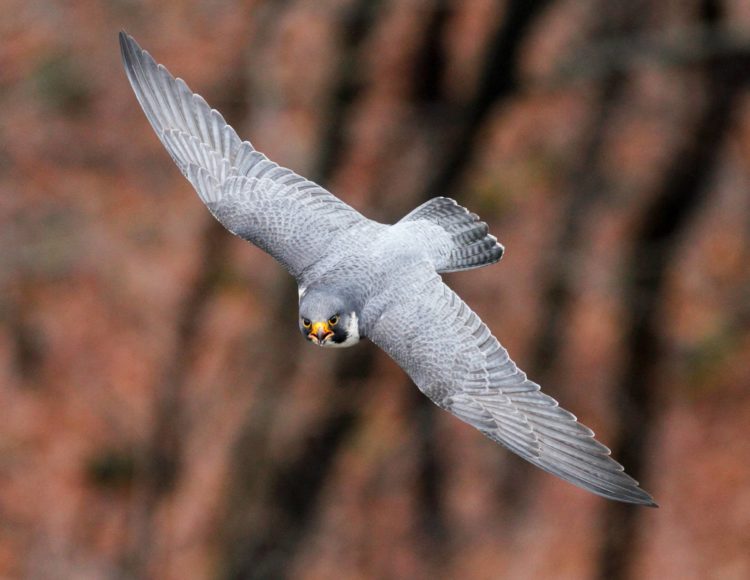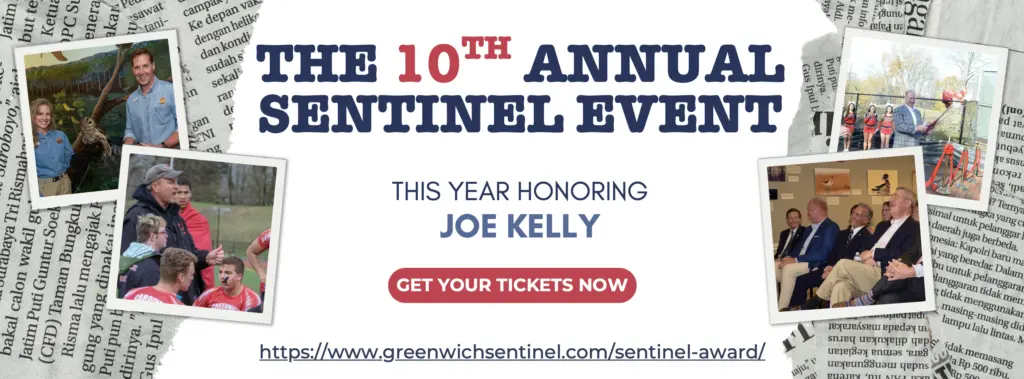Time to make a 50th anniversary visit to the Quaker Ridge Hawk Watch But first a Hawk Watch primer with Audubon educator Ryan MacLean

By Anne W. Semmes
A week Saturday Audubon Greenwich will kick off its 50th anniversary Quaker Ridge Hawk Watch Weekend at its Audubon Center site in backcountry. And the count is on of those amazing birds of prey that are migrating through Connecticut. Diligently keeping tabs is official hawk counter Harry Wales, adding daily to the Quaker Ridge site online at Hawkcount.org
To prepare us birdwatchers for this event Ryan MacLean, Audubon’s 4H Education Specialist for the Center recently gave an astounding one hour talk on hawks in the Melissa Groo Gallery, surrounded by Groo’s bird photographs. He reminded us of the birth of the Center in 1943 making it National Audubon Society’s oldest nature education center in the country, doing its best to educate us and engage us in what Ryan calls community science.
“Community science” he tells, “is directly assisting in an understanding of how our ecosystem is doing… how we can help our Earth. And our longest-running and probably our most significant and most publicly accessible community science project continues to be our Quaker Ridge Hawk Watch.”
We have a lady called Rosalie Edge to thank for establishing in 1934 that Hawk Mountain Sanctuary in Pennsylvania and turning people away from shooting hawks there to watching them migrate along the mountain ridges. Other hawk watching sites then developed, with a network of sites in Connecticut. And wasn’t Quaker Ridge prime at 510 feet high? These ridges tell Ryan bring updrafts, “when the wind hits a mountain ridge, then shoots up,” it gives the hawks, “a little column of air that they can just coast on like a magic carpet ride, and not have to flatten their wings.”
“They’ve got a north wind behind them,” tells Ryan, then spells out what he describes as ideal hawk migration watching time:
“Typically, from our site, days with Northwest winds 10 to 12 miles an hour pushing them down our way…And this is the reason why our hawk watch is so significant because of where we’re located, they have mountains that the birds are coming down from, along from Massachusetts, Western Connecticut, they reach here still coasting down on some ridges. We’re the very last one on that line and they are still about 510 feet.”
Clouds also help hawk watchers. Hawks love all blue sky, he says, “because they can get to thousands of feet, but not very easy for us to see at that height. Clouds help to give us something of a backdrop to see the silhouette of birds against. We like puffy clouds, partly cloudy skies.”
And those hot air thermals the Broad-winged Hawks especially love. “Because when these birds are coming, they find those thermals that can give them air to lift off, you’ll see not just a few, but you’ll see sometimes hundreds of them circling in one of those hot air thermals. We call that a kettle of hawks because it kind of looks like they’re boiling bubbles of water or a hawk tornado. That’s the magic of what happens here in September if you come on the right day and the right time. The magic days have typically been September 17, 18, 19.”
And how are those swirling hundreds of hawks counted? “Our hawk counters have little clickers, and we’ll watch them as they’re circling in that kettle, going ooh and ah. They’ll make tighter circles than those Red-tail Hawks will do, too. But then they’ll widen-out in a straight line. When we see that, we start clicking them off as they come over.”
And what are some of those historical kettle numbers? “Our site has held record days in the Northeast on two occasions, one in the eighties, one in the nineties, over 30,000 Broad-winged Hawks were counted in one day here. That hasn’t happened in nearly 30 years, but some days can still be quite amazing if you get the right conditions.”

To help us in identifying hawks Ryan gives us near encyclopedic information on the shapes of hawks (and their diets!). He starts with “one of our familiar birds, the Red-tail Hawk,” with “long, square, rectangle wings, long tail.” But he notes that juveniles don’t have red tails.
“They have a brown-colored tail, usually a bit longer than the adults, because that helps them to learn to fly better.” And speaking of flying, the Red-tail is unique in its kiting – “If they see something down below them, they can stop in mid-air…staying almost completely still in the air.”
Red-shoulder Hawks have “brilliant rusty patches on the top part of their wings…They also have a banded tail instead of a red tail.” And the Broad-winged Hawk that migrates all the way “to the rainforests of Brazil, Ecuador, Venezuela, Chile, and other South American countries to find food for the winter,” has those broad wings and telltale black and white bands on their tails.
“One of our smallest hawk species is the Sharp-shinned Hawk,” Ryan tells. “Next to the Broad-winged it’s probably the species of hawk we count the most of in a season…They’ve got a really small little head, really small little beak. But look at the tail, really long and thin…it acts as their steering wheel,” and, “They love to eat small birds.”
Ryan ended his talk on those “fighter jets of the raptor family, our falcons.” With wings like fighter jets, “Their specialty is catching their prey in the middle of the air.” And which bird is the fastest animal on earth? The Peregrine falcon. “This species has been clocked out at over 200 miles an hour.” We nearly lost this species with DDT, but they are wonderfully being sited now at the Audubon Center – Quaker Ridge.
Ryan had so much more to tell, like the numbers of raptors that gather in Panama after their long journeys. Ryan’s friend and director of Panama Audubon reported counting two million raptors! “What was that like?” emailed Ryan. “Everyone in Panama City saw all these birds migrating over. They had to shut down the international airport.”
September 24 and 25 will not be the traditionally large scale of this 50th Hawk Watch Weekend. But the hawks will assuredly be on view from 9 to 5, as will Ryan MacLean, Education Specialist, giving a “Hawks in Flight Identification Workshop” both days from 11-12. And there will be raptors galore being presented on both afternoons.
Ryan adds a last welcoming note: “During this period of peak raptor migration we anticipate large numbers of species such as Bald Eagle, Osprey, Sharp-Shinned Hawk, American Kestrel, and, on days of ideal weather, thousands of Broad-winged Hawks on a single day.”
To register Ryan asks you to visit https://greenwich.audubon.org/visit/quaker-ridge-hawk-watch-weekend-2022







